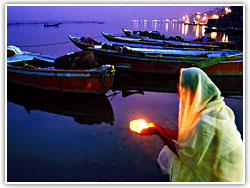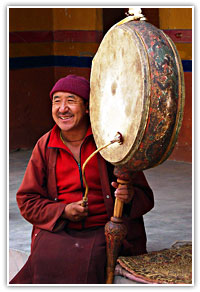|
|
Religions of North India
.............................................................................................................................................................................. |
|
In the olden days, the people of
India were not city-dwellers. They lived in the forests
and enjoyed the kind of life which the dense forests
offered. Most of the myths revolved around trees,
Yakshas, snake spirits, Nagas, Nagins, etc. Today, India
is the home to all the world's major religions. About
80% of the people of India are Hindus. Besides this
there are various other people belonging to various
communities like Muslims, Sikhs, Christians, Buddhists
and various other religious groups. One of the most
important feature of the Indian religion and the social
life is the caste system. After independence there has
been significant changes in the caste system, but still
in India most of the people are identified as the member
of the particular caste group. |
| |
|
|
|
Hinduism
The origin of the modern Hinduism can be traced
back about more than 2000 years ago, but today
there has been some major changes in the belief
and practice. The Aryans were the first people who
came to India and settled in the Indus and
Gangetic plains. The actual history of the Aryans
seems to be recorded in the two great epics, which
are the Ramayana and the Mahabharata. The Lord
Krishna who was considered as the Supreme god at
that time, |
 |
|
|
was later worshipped by many
devotees. Between the 4th and 9th centuries, some of the
various ancient gods and goddesses of the Vedic period
appeared and were later worshipped like the Brahma, Agni,
Surya, Indra, Shiva, Vishnu and Shakti. For most of the
Hindus today, worship is regarded as an integral part of
the faith. The great majority of the Hindus worship
these gods in the temples and also have a small shrine
in their homes.
Jainism
The Lord Mahavira founded Jainism around 500 BC. He was
very kind hearted towards all beings and rejected the
Hindu belief that the Supreme Creator had created this
universe. The Jain monks became embodiments of total
renunciation and wore fewer clothes. A begging bowl and
a stove were their only possession. They covered their
mouths to avoid any living insect accidentally entering
their mouth and that is how they preached non-violence.
In the course of time, non-violence also became an
essential element of Hinduism. Various Hindu thinkers
provides respect to the others’ beliefs.
Islam
Muslims are the largest minority of India. They
constitute a majority in the Kashmir Valley, and are
evenly spread in Uttar Pradesh and Bihar. The majority
of Muslims are Sunnis, who follow the descendants of
Mohammed’s direct successor, the Caliph, while other
Muslims are Shiaites who are the descendants of the
Prophet’s son in law, Ali. Both the sects visit Mecca
which is Prophet Mohammed’s birth place.
Sikhism
Sikhs constitute about 2% of the Indian population.
Sikhism was founded by Guru Nanak (1944-1538), and
originated as a Bhakti movement. He rejected the caste
system and treated everyone equally. Sikhism is a fairly
new religion, which split from Hinduism in the 16th
century. It grew in response to conflict between Hindus
and Muslims in Punjab forced by the terrible suppression
by the Muslim rulers. Provoked by Aurangzeb's hostility
the tenth Guru, Guru Gobind Singh, enjoined upon all
Sikhs to take the surname ‘Singh’ (Lion). The Sikhs
believe in one God and worship him in their temples
called Gurudwaras. Their holy book is the Granth Sahib,
a collection of the teachings of their Ten Gurus and
other contemporary saints, both Hindus and Muslims. The
tenth Guru, Gobind Singh, ordered that there would be no
more Gurus after him and that their sacred book, the
Granth Sahib, should be read for guidance. Their holiest
city is Amritsar with its Golden Temple called Harmander
Sahib. |
| |
|
Buddhism
India was the home of Buddhism, but today it is
practiced only on the margins of the
sub-continent, in Leh, Ladakh, Nepal and Bhutan.
Today, there are approximately 5 million Buddhists
in India, who worship the Lord Buddha, also known
as the Gautama. There are various places of great
significance for Buddhists around India like
Lumbini, the Buddha’s birth place, Bodhgaya, where
he attained enlightenment, the deer park at
Sarnath, where he preached his first sermon, and
Kushinagara, where he died at the age of 80.
Besides this there are remarkable monuments,
sculptures and works of art in Sanchi and Ajanta,
where it is still possible to view the flowering
of Buddhist culture in India.
Jews
Jews in India, have lived in Cochin for almost
3000 |
 |
|
|
years.
Their migration dates back to 973 AD when King Soloman’s
merchant fleet started trading with Kerala for spices
and silver. They originally settled on the Malabar
coast. The Dravidian King of Cochin treated them well
and granted a piece of land to Josepin Rabban, a Jewish
leader. They prospered and have lived peacefully over
the centuries in Kerala. Now, only some of the Jews are
there as most of them have now migrated to Israel. It is
possible to see some old Jews in the Cochin synagogue,
one of the oldest in the world.
Zoroastrianism
Zoroastrianism was founded by Prophet Zoroaster around
800 BC. A good example of India’s hospitality towards
the offended people of the world can be seen in the
treatment of Zoroastrians who came to Gujarat (India)
from Iran around AD 766. They are called Parsis in India
and reside in Mumbai and other places of India. Over the
centuries, they have tried to preserve purity in their
blood by intermarrying among themselves. Of late, this
system is breaking down as many Parsi boys and girls do
not feel the necessity to marry among themselves. The
advent of Islam in Iran led to their maltreatment and
they found India safer. The Zoroastrian holy book is the
Zend-Avesta, which describes the ongoing battle between
good and evil. They worship Ahura Mazda, who is
symbolized by fire. Parsis worship nature’s elements and
are fire worshippers, keeping the symbol of their belief
burning in their temples. |
|